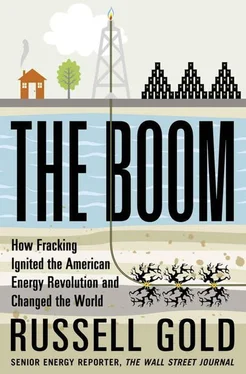The global energy system is vast. It won’t change quickly. It is the foundation of modern life, and due to climate change, it poses a threat to modern life. The energy unearthed by fracking is both a once-in-a-lifetime opportunity and an enormous challenge. The rise of fracking is a story of ambition and resourcefulness. It is a tale that could occur only in the freewheeling United States, a nation of an enormous energy appetite, with no discernible policy on providing that energy, and a willingness to turn its back on Ottis Grimes. The Earth is warming, and once the source rock is depleted, the era of fossil fuel will end whether we are ready or not. Fracking has changed the energy industry and is changing the world around us. It is here to stay.
3

EVERYONE COMES FOR THE MONEY
A few miles south of Killdeer, North Dakota, amid rolling grassland that stretches out of sight in all four directions, two dozen men huddle close together to hear Josh Byington over the blustery prairie wind. “Welcome out here, gentlemen,” says Byington, his hooded eyes peering around from under a hard hat. Everyone but him wears identical dark blue coveralls with silver reflective stripes around their arms. Each has an American flag patch on the right arm and the North Dakota state flag on the left arm. Some workers left their hard hats unadorned except for the name of their employer. Others personalized their hats with stickers. One guy had “Frackn8r” on his hat. Another: “Coon Ass.”
Byington is youthful and trim. Only when he takes off his hard hat (sticker free) do you see that his sandy hair is being gradually overrun by white. Just shy of forty years old, he has two decades’ experience in the oil fields of North Dakota, Wyoming, and Colorado. At this prefrack safety meeting, his word is final. Talk to the workers whose shift is ending, he urges. Learn if there have been any problems. When we’re pressuring the pipe to test it, don’t stand near the iron. Be careful. Be smart.
“Pay attention to what is going on. This is big business. Hit the wrong switch, it could be your life or someone else’s.” He pauses. “No one gets hurt today, right?”
There are murmurs of assent. One worker yells, “Exactly!”
“All right, gentlemen,” Byington says as he looks around, “let’s go have some fun.”
———
I have come to North Dakota to observe the fracking of the Irene Kovaloff 11-18H, a well on the southern edge of the Bakken Shale. There is nothing exotic about the well. It is one of a crowd of one hundred wells that will be fracked in the United States on this particular day in October 2012, ten in North Dakota alone. I could have chosen any number of places to witness a frack. But North Dakota offered an unvarnished view of the industry at full throttle. Trucks crowded the roads. In nearby Dickinson, where I stayed for a few days, the city engineer had resigned a week earlier, citing his increased workload and stress. That’s what happens when five thousand new residents move into a city in two years, making one of every four Dickinsonians a recent arrival. In the midst of a sluggish national economy, locals advertised five openings for every person seeking a job.
Energy companies have come to North Dakota because when they frack the Bakken, light sweet crude oil comes out of the rock. Other shales offer mostly natural gas, which by the middle of 2012 was so plentiful there was a glut. So the rigs and the frack crews migrated to the Bakken. The industry is moving so quickly that the pipe layers can’t keep up. Trucks haul the crude to rail depots, where it is loaded onto railroad cars. The wells here produce a bit of natural gas also, and no one wants to wait around for a connection to a gas pipeline, so they flare it off. At night, the onyx sky flickers with gas being burned off. One night I drove out from Williston, another oil boomtown, in search of a flare and found one within five minutes. Flames roared in a pit on the side of the road like a giant, unattended bonfire.
Over my journalism career, I have visited dozens of wells. But I had never spent time at the well as it was fracked. I felt a bit like a baseball fan who scanned the box scores and followed the standings closely but had never watched a game. I wanted to take my seat and settle back to watch the whole nine innings. Getting a ticket, however, wasn’t easy. I called several companies active in the Bakken. They turned me down. One told me it was too busy to have its people take time off to “babysit” a visitor. Another said it just wasn’t interested. Finally, Marathon Oil, a Houston corporation that generates an annual profit larger than the gross domestic product of some small countries, agreed to let me spend time on a frack job. The decision went all the way up to the chief executive. He decided that the industry had been hurt by its secrecy. When I got the okay, I went out and purchased a pair of steel-toed work boots.
A few weeks later, I waited in a North Dakota hotel room. The prairie winds had been near hurricane strength for an entire day, causing operations to come to a standstill. When my cell phone rang, a Marathon official told me that the winds had died down enough to allow the fracking of the Irene Kovaloff. I hopped in my rental car and headed north from Dickinson to meet my Marathon handlers.
———
Josh Byington oversees the movements of the couple dozen coverall-clad workers. His directive is simple enough: force more than one million gallons of liquid into the Irene Kovaloff under enough pressure to crumple the toughest car Detroit can turn out. Until his replacement arrives later that night, he makes sure the cocktail of water, sand, and chemicals was mixed just right. He checks that every flange is in place and every bolt secure. On this cold October day, the Bakken rock underfoot is the same thick, impermeable layer that it has been for the past fifty million years. By the time Byington has slept for a few hours and returned for his next shift, a full twenty-four hours after the fracking began, this section of the Bakken will be filled with thousands of tiny fractures, smashed into pieces like a shattered dinner plate. A week later, the valves atop the well will be opened, and crude oil will begin to seep through these new networks into the well. It will be pumped to the surface and, after being processed in a refinery, will end up as gasoline in automobile tanks and fuel in the airplanes overhead. By then, Marathon will have fracked several more wells.
The Irene Kovaloff, a recently drilled, long, and narrow hole in the ground, went straight down two miles until it reached the Bakken Shale, and then made a gradual 90-degree turn and continued for another two more miles in a southerly direction. Once fracked, the Irene Kovaloff dribbled forth a thousand barrels a day of crude for the first few weeks. Then the oil flow started to decline. By itself, the Irene Kovaloff is a drop in the global bucket. But Irene isn’t alone. Nearby is her sister, the Viola Koberstine 34-7H. And not far away are relatives and neighbors: the Willard Kovaloff 21-17H, the Darcy Dirkach 14-12H, the Louie Hendricks 24-20H, the Wm. and Agnes Scott 14-25H, and the his-and-hers wells, the Tom Steffan 21-27H and the Deanna Steffan 44-22H. And so forth and so on across the prairie. Compare the list of well names to North Dakota homesteaders, and there is significant overlap.
———
Before workers transform the Irene Kovaloff into a producing oil well, they must make sure everything is secure and ready. When the prefrack safety meeting ends, a class system among the workers becomes visible. Most of the men head in one direction, where they check water levels in the rows of blue trailers, stand amid clouds of silica dust to make sure the sand doesn’t fall off the conveyor belt, or tend to the dozens of machines. They spend their shift smelling musty diesel and tie their hoodies around their faces to keep out the cold. It is in the high thirties, but the constant wind makes it feel significantly colder. A smaller group heads in another direction and climbs a few steps into a temperature-controlled trailer called the data van. They spend their shift inside, peering out of thick-paned windows at the well, giving orders through headsets. They take off their hard hats and strip down to T-shirts under their coveralls. There is a coffee urn at their disposal. A car stereo bolted into a wall panel keeps them entertained during overnight shifts. On a recent night, Pink Floyd’s The Dark Side of the Moon accompanied a frack. The next night it was Ted Nugent. The guys outside hope to work their way into a data van job.
Читать дальше













